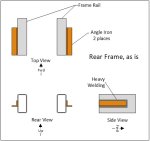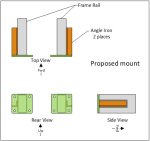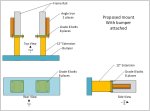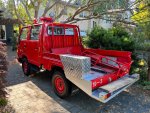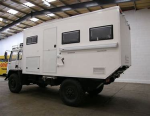Are there recovery points you can use on the existing frame, and can you mount the camper to the existing frame? My camper extends ~20" past the frame and the bumper a couple more. The bumper is on the light side and the only load is the step for getting in and out. Recover points are on the beefy hitch which is in the stock location and bolts to the frame.
Bikes are not heavy. If you have a side entrance you could mount the bikes to the camper itself, which might be easier.
You say that the frame is heavy duty, but just be aware that a large load with a CG behind the rear axle can be problematic. If it's fully boxed I very much doubt you'd have an issue with solid attachment.
What sort of camper are you planning?
There are no good recovery points on the frame. I think the end was simply lopped off to add the step bumper. I'm currently fabbing a simple beefy bumper with receiver and it will connect with the frame extension to add recovery points in line with the frame.
Bikes are "Light", but my Mountain bike is ~35 lbs, my SO's is ~30, and the rack is 50, so it's a fair amount of weight cantilevered off the back.
I am planning a side entrance pop-up camper. The width of the door is the primary reason I need to extend the frame. I can't fit a door in front of the rear wheels, so I'm adding it aft of the rear wheels. I also want to stay under 7'6", as I'm hoping to ship this rig over seas at some point.
I am very aware of the issues loading aft of the rear wheels. Having the entry back there requires me to keep it open. All of the heavy stuff (batteries, water, fuel, etc...) will be in the forward section.
Here's a sketch that I use to plan the CAD model:

I want to keep it as small as possible. Just a bit of living space and a bed.
I guess if I went with a rear entry floor plan I could make the whole thing shorter, which isn't a terrible idea. I could improve the departure angle. I was hoping to store a spare back there, but it might be worth it.
I'm pretty sure the camper will not have any fancy articulated mounts. As I said before, it's a landcruiser 7X series frame. I've done some preliminary flew tests and seen no movement, which makes sense since the rear wheels are so close to the cab. I need to load it a bit more and get the wheels higher before I'm sure to mount it directly. Earthroamer does a baby RV on the landcruiser frame without an articulated mount, so maybe it will work?
Someone is going to pop in here and ask why I'm not using SIP Panels. It's because I don't need the insulation, and I don't want a 2"+ thick wall. I can weld an aluminum frame, skin it with DiBond and save a lot of weight and cost.
